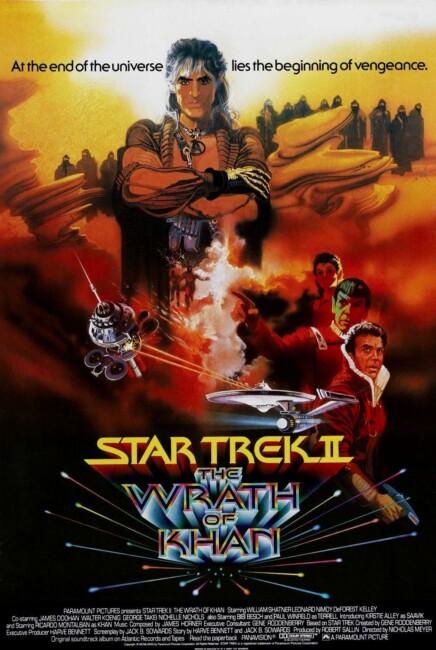USA. 1982.
Crew
Director – Nicholas Meyer, Screenplay – Jack B. Sowards, Story – Jack B. Sowards & Harve Bennett, Producer – Robert Sallin, Photography – Gayne Rescher, Music – James Horner, Visual Effects – Industrial Light and Magic (Supervisors – Ken Ralston & Jim Veilleux), Computer Animation – Digital Inc, Special Effects Supervisor – Bob Dawson, Makeup – Werner Keppler, Production Design – Joseph R. Jennings. Production Company – Paramount.
Cast
William Shatner (Admiral James T. Kirk), Leonard Nimoy (Spock), Ricardo Montalban (Khan Noonian Singh), DeForest Kelley (Dr Leonard McCoy), Walter Koenig (Chekov), James Doohan (Mr Scott), Bibi Besch (Dr Carol Marcus), Kirstie Alley (Lieutenant Saavik), Merritt Butrick (David Marcus), Paul Winfield (Captain Clark Terrell), George Takei (Sulu), Nichelle Nichols (Uhura), Judson Scott (Joachim)
Plot
Chekov is now assigned aboard the starship Reliant under Captain Terrell on a mission to find an uninhabited world for the Genesis research project. On the inhospitable desert world of Ceti Alpha V, they find Khan Noonian Singh, the genetic superman from the 20th Century Earth that Captain Kirk abandoned there years ago. Kirk believed he was sending Khan and followers to the inhabitable Ceti Alpha VI but by accident exiled them to this desert world. Khan takes over the minds of the Reliant crew using a native parasite. He then commandeers the Reliant to steal the Genesis Device – a bomb that can terraform barren worlds into hospitable ones but could also totally wipe out any living planet it is released on. Armed with the Genesis Device, Khan comes, determined to obtain revenge on his old nemesis Captain Kirk.
Following the success of Star Wars (1977), the cult tv series Star Trek (1966-9) was given its long promised big-screen revival. This emerged as Star Trek – The Motion Picture (1979) with a $47.5 million budget that made it the then most expensive film ever made. Star Trek – The Motion Picture ended up being one of the largest follies of the post-Star Wars science-fiction boom, with massive cost wastage and creative troubles behind the scenes such that it failed to break even in its initial theatrical release. Moreover, it was hated by the series’ legion of fans who felt (justly so) that the cosiness and the beloved characters of the original series had been left behind and the production hijacked by the special effects artists. (Although in this author’s opinion, Star Trek – The Motion Picture is by no means a bad film – see above link for comments).
What did not go unnoticed by Paramount Pictures was that Star Trek – The Motion Picture had earned enough to still put it on the then list of the Top 50 All-Time money-making films of the day, even if that was still not enough to recoup its sprawling budget. Paramount decided to back a second film, albeit one that was made far more modestly – only around a $12 million budget, nearly a quarter of what the original had cost.
Series creator Gene Roddenbery had initially toyed with an intriguing script that involved the Enterprise crew travelling back in time to deal with the JFK assassination. Instead, Paramount rejected Roddenberry’s idea and bypassed him altogether. Despite having created the original series, Gene Roddenberry was made into the sacrificial goat for Star Trek – The Motion Picture‘s failure and would only be given a nominal ‘Star Trek Created by …’ credit on the films that followed from this point on.
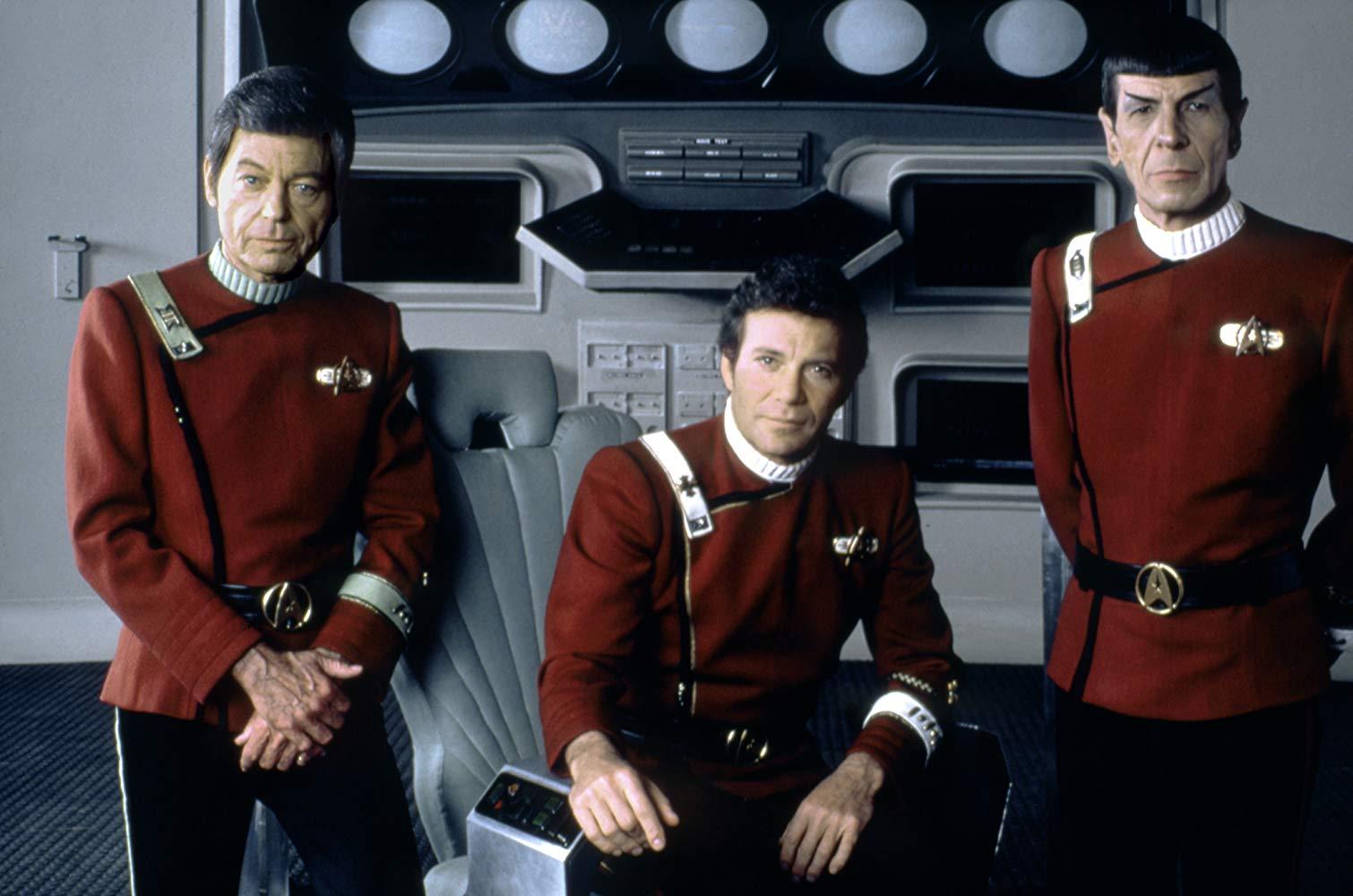
Indeed, while Roddenberry’s position in the Star Trek pantheon is akin to Jehovah in Judaeo-Christendom, his position in the modern versions of Star Trek is almost criminally slight. After his dismissal from the Star Trek films (and their subsequent shanghaiing by the members of the original cast), Roddenberry returned to television as creator and producer of Star Trek: The Next Generation (1987-94), which in the first three seasons that Roddenberry presided over proved to be a deeply problem-ridden series behind the scenes with a virtual revolving door of dissatisfied script editing and producing talents. It was only, with occasional exceptions, after Roddenberry began to be creatively shut out of Star Trek: The Next Generation by Paramount about the middle of its third season, that the series began to creatively grow beyond shuffling around tired Society of the Week moral dramas as the original series had done and began to develop sharp, intelligent hard science stories and a strong character ensemble and grow into the fan favourite it did.
As Roddenberry’s other tentative ventures into televised science-fiction – the Genesis II (1973) and Planet Earth (1974) tv movies and posthumously produced tv series like Earth: Final Conflict (1998-2001) and Andromeda (2001-5) show – he was a producer who lived on an old model of science-fiction, as perpetuated by Star Trek, of creating cardboard societies of the week for The Enterprise, as the torch-carrier of Peace Corps era democracy, to symbolically dismantle. In the 1980s and beyond, this began to look decidedly outmoded.
The new carrier of the classic Star Trek torch from here on would become Harve Bennett. Bennett came from a background in television as producer of series like The Six Million Dollar Man (1973-8), The Invisible Man (1975) and The Bionic Woman (1976-80), and would go onto produce Star Trek‘s II through VI. Harve Bennett handed scripting chores for Star Trek II over to Jack B. Sowards, whose previous claim to fame had been as story editor on Bonanza (1959-1973). Sowards later confessed that he had never watched the original Star Trek but told Bennett that he did, went away and watched the episode Space Seed (1967) and promptly crafted a sequel to it. Despite Sowards’ avowed lack of knowledge about the original, Star Trek II: The Wrath of Khan promptly became a fan favourite and the most beloved of the Star Trek films for its handling of the characters.
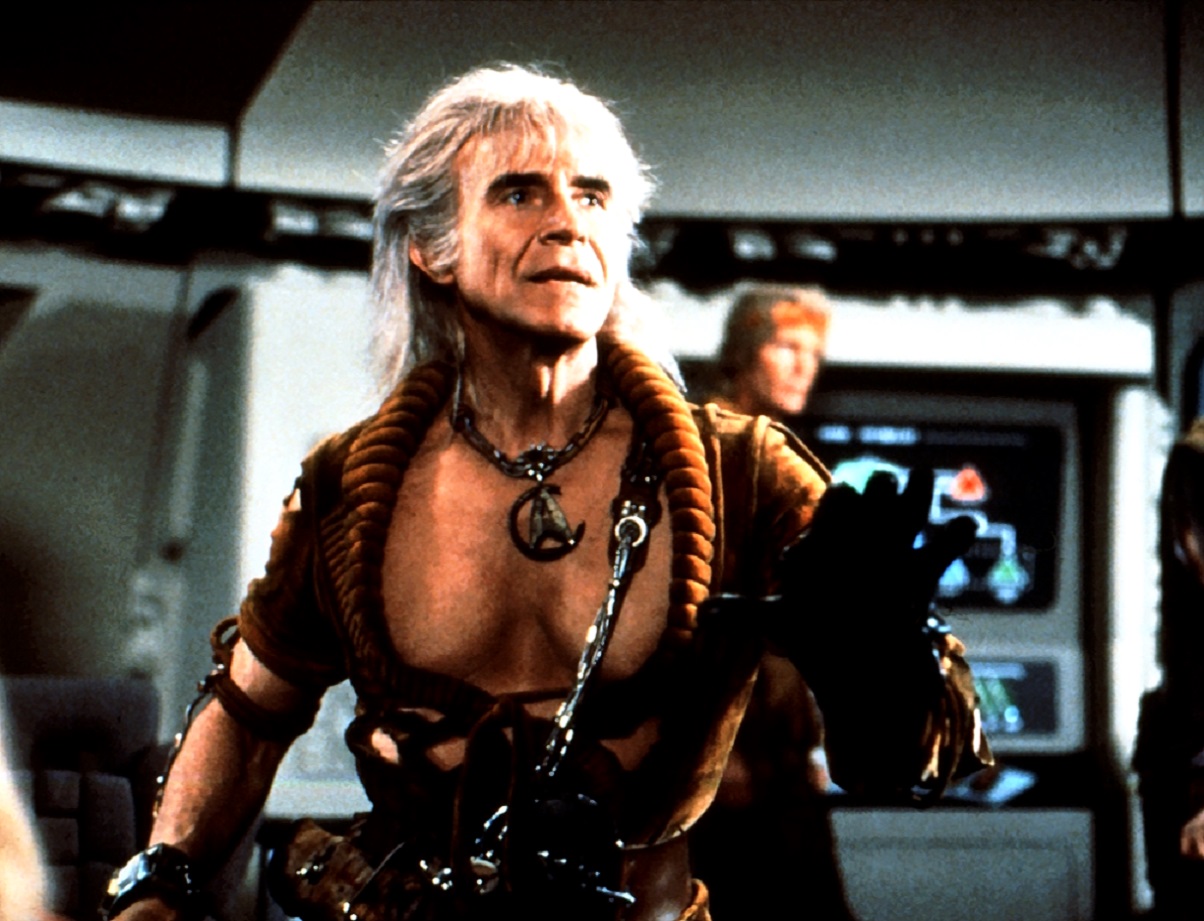
The directorial chores for Star Trek II: The Wrath of Khan were handed over to Nicholas Meyer. Nicholas Meyer was a novelist who came to attention with two witty Sherlock Holmes pastiches The Seven Per Cent Solution (1973) and The West End Horror (1976), which placed Holmes up against real historical characters such as Sigmund Freud, Oscar Wilde and George Bernard Shaw. The first of these was adapted into a successful film The Seven Per Cent Solution (1976) with a screenplay by Meyer. Meyer then parlayed that success into directing a witty little time travel film Time After Time (1979), which engaged in similar historical game-playing in having H.G. Wells having successfully constructing his own time machine and pursuing Jack the Ripper to modern day San Francisco. (See below for Nicholas Meyer’s other films).
The great controversy before Star Trek II: The Wrath of Khan premiered was the leaked knowledge that the series cult figure of the coldly logical half-human, half-alien Spock would be killed off. Distraught Trekkers threatened to boycott the film, even taking out newspaper ads to protest to Paramount. It seemed a creative decision tailored more to Leonard Nimoy’s perpetual vacillation regarding the role than anything else. Nimoy had written an autobiography I Am Not Spock (1976) and then in 1977 held back from signing on to reprise the role of Spock for the planned Star Trek tv revival due to a lawsuit he had launched against Paramount for the use of likeness in the selling of merchandise without paying him royalties. The character of an alternate Vulcan science officer Xon had been created and cast to get around his absence. By the time the tv revival had evolved into Star Trek – The Motion Picture, Leonard Nimoy had settled the lawsuit. Star Trek II: The Wrath of Khan seemed written to kill Spock off once and for all. However, by the next film, Star Trek III: The Search for Spock (1984), Nimoy had parlayed his fan popularity into getting the opportunity to direct the film in agreement for his return. His subsequent creative control as both director and producer on the later films obviously satisfied his indecision enough for him to then turn around and write a new biography entitled I Am Spock (1995).
Star Trek II: The Wrath of Khan is a fan favourite because it spends more time on the characters than any of the other films. In all but the last Classic Star Trek film, what amounts to characterisation fell into a lazy middle-aged humour. Moreover, Star Trek II: The Wrath of Khan is almost at complete opposite to what the first film was – where Star Trek – The Motion Picture was extravagant special effects for their own sake and reached for cosmic mind-stretching regard, Star Trek II: The Wrath of Khan is modest and cosy and lets the characters fill the screen with a warm and often endearing regard. The Wrath of Khan is what the first film should have been. It is a film about accepting middle-age – Kirk comes to terms with needing spectacles, the wild oats of his youth come to haunt him, he suffers from the midlife crisis of yearning for youthful adventure again, while the end of the film movingly manages to be about coming to terms with death, arriving on a eucatastrophic sacrifice for others (Spock’s coffin coming to land on the Genesis planet is pointedly contrasted with the sudden miraculous spring-like arrival of new life).
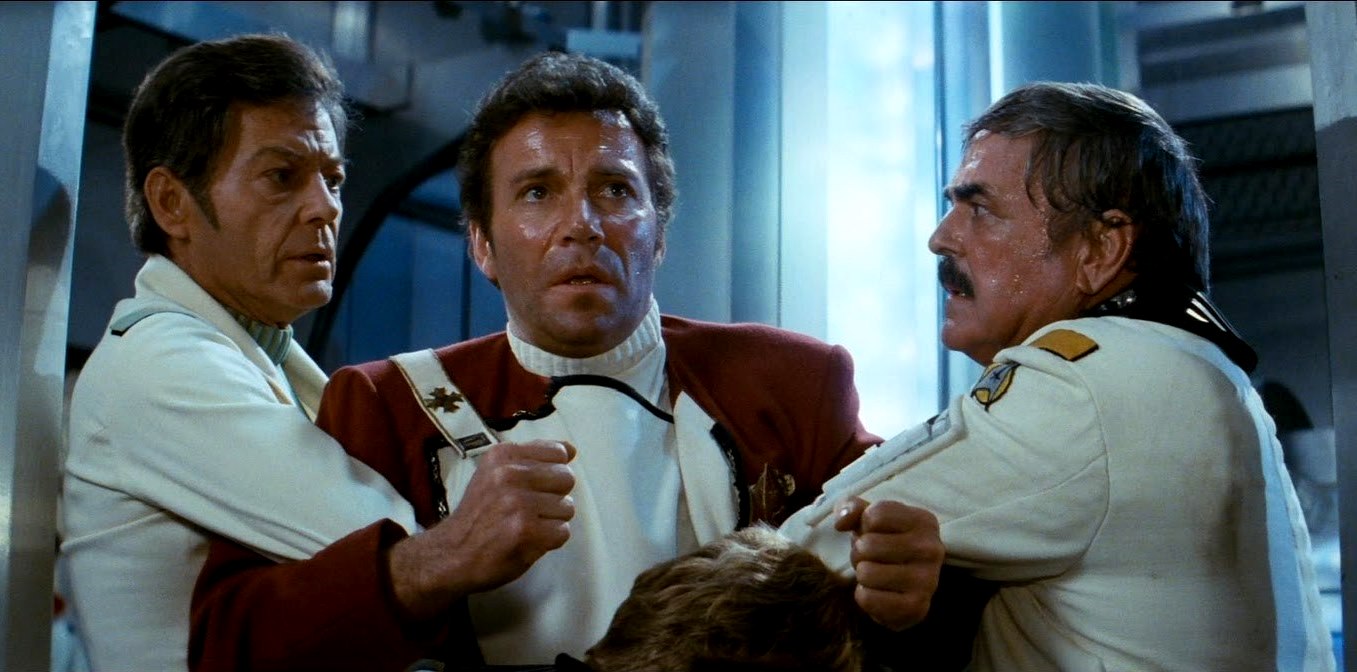
Ironically, these genteel and often moving meditations about the arrival of middle-age ended up being entirely lost on the actors playing the parts who subsequently placed their creative control on the next three films in the series, which then became about everything but learning to gracefully accept getting old, where the image of a group of no-longer-young actors gallivanting about the universe playing boyscouts only drew attention to itself by the increasingly forced attempts to ignore the creeping age factor. What the subsequent films did ironically end up doing was to give the fans exactly what wanted when they protested against the killing of Spock – the pandering to sentimental sensibility rather than allowing characters to dramatically progress or even the real world tragedy of death to intrude into the fictional bubble. Naturally the fans ended up hating most of the cosy, comfortable subsequent entries, while Star Trek II: The Wrath of Khan usually vies with The Voyage Home: Star Trek IV (1986) as being the fan favourite among the films.
Nicholas Meyer does an excellent job with the film – indeed, this is the best film in his sporadic directorial oeuvre. Despite being made on a much smaller budget, Industrial Light and Magic are on board and create some excellent special effects sequences. (Although the film is not so corner-pinching that it is not above rehashing several effects shots from Star Trek – The Motion Picture). Nicholas Meyer has stated in interviews that his model for these sequences was old WWII submarine dramas and the scenes zing with marvellously suspenseful psychological tension, as much for the excellence of the effects sequences as they are for Meyer’s concentrating them on Kirk’s sly outwitting of Khan.
The film really belongs to William Shatner. Shatner, for all that he has been called a bad ham actor, is one who is never more at home in the part of Captain Kirk than he is here and in The Search for Spock, films that allow him to rise and fill the part with grand dramatic flourish. He is more than ably balanced out here by Ricardo Montalban who plays Khan with marvellous ham theatricality, while Nicholas Meyer characteristically arms him quotes from Shakespeare and Herman Melville.
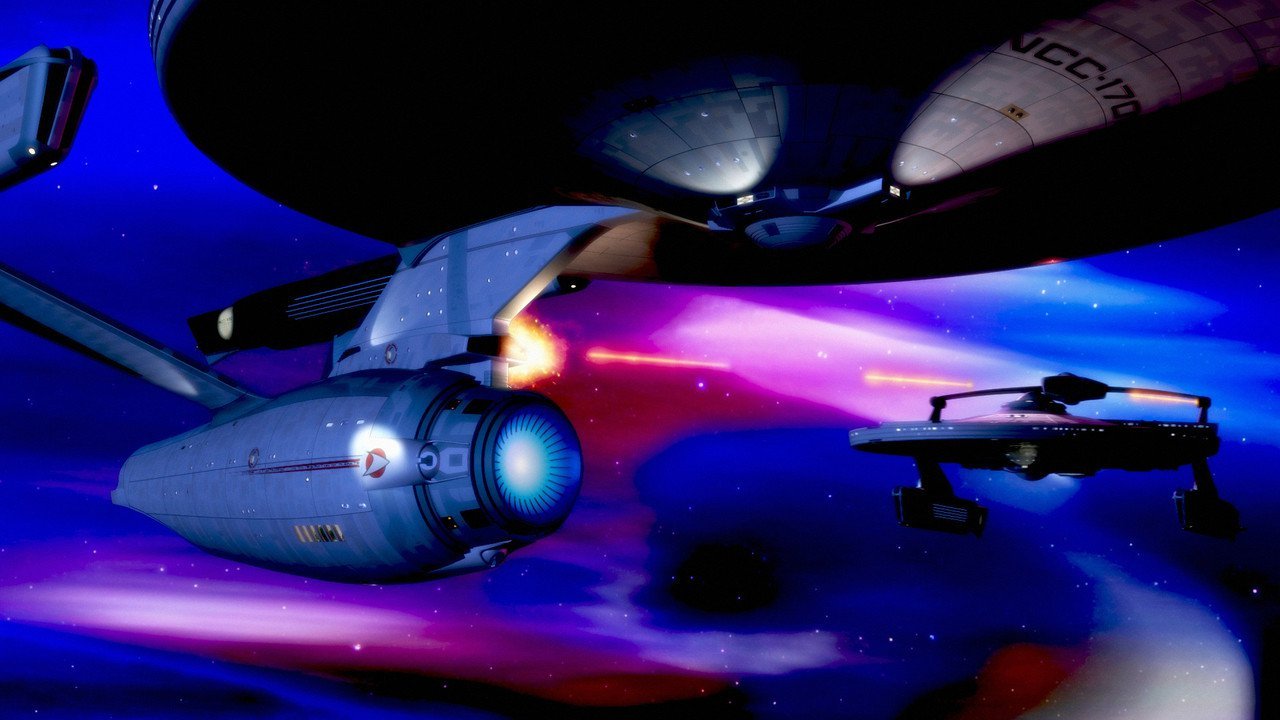
There is the promising debut of new characters, especially the introduction of Kirstie Alley as the perky and intriguing new character of the Vulcan-Romulan officer Saavik. Alas, Saavik was a character that was thrown away in the subsequent two sequels – not to mention blandly replaced by Robin Curtis when Paramount refused to capitulate to Kirstie Alley’s demands for increased salary on the next film. Saavik is an intriguing character that one would like to see make a reappearance in one of the modern Star Trek series.
The other Classic Star Trek films are: Star Trek – The Motion Picture (1979), Star Trek III: The Search for Spock (1984), The Voyage Home: Star Trek IV (1986), Star Trek V: The Final Frontier (1989) and Star Trek VI: The Undiscovered Country (1991). (In an interesting aside, The Undiscovered Country – a phrase from Shakespeare’s Hamlet (1602) that essentially refers to death and what waits beyond – was originally the subtitle for The Wrath of Khan, before being canned by Paramount as too obscure). The second generation Star Trek tv series are Star Trek: The Next Generation (1987-94), Star Trek: Deep Space Nine (1993-9), Star Trek: Voyager (1995-2001) and Enterprise (2001-5). Star Trek: Generations (1994), Star Trek: First Contact (1996), Star Trek: Insurrection (1998) and Star Trek: Nemesis (2002) are films based on Star Trek: The Next Generation. Star Trek (2009), Star Trek: Into Darkness (2013) and Star Trek: Beyond (2016) were reboots of the classic series, which recast the classic roles with new faces. (Into Darkness featured an appearance from a very different Khan now played by Benedict Cumberbatch). The third generation revival tv series are Star Trek: Discovery (2017-24), Star Trek: Picard (2020-23), the animated Star Trek: Lower Decks (2020- ), Star Trek: Prodigy (2021- ) and Star Trek: Strange New Worlds (2022- ). Star Trek: Section 31 (2025) was a film spinoff from the revival series.
Nicholas Meyer would subsequently go on within the genre to direct the controversial tv movie The Day After (1983) about nuclear war, the little seen Merchant-Ivory production The Deceivers (1988) about Indian Thuggee cults, before returning to the Trek series with script input on The Voyage Home: Star Trek IV (1986) and to helm the last of the classic Star Trek films Star Trek VI: The Undiscovered Country (1991). Nicholas Meyer’s other genre work includes the screenplays for the amusing Invasion of the Bee Girls (1973) and The Night That Panicked America (1975), a tv movie based on the panic surrounding the Orson Welles War of the Worlds broadcast in 1938. From the late 1990s, Meyer moved away from directing to writing scripts such as Sommersby (1995), The Prince of Egypt (1998), The Human Stain (2003) and Houdini (tv mini-series, 2014), plus created the tv series Medici, Masters of Florence (2016– ). He also produced the epic tv mini-series The Odyssey (1997), the Arnold Schwarzenegger action vehicle Collateral Damage (2002) and the tv series Star Trek: Discovery (2017-24).
Trailer here


